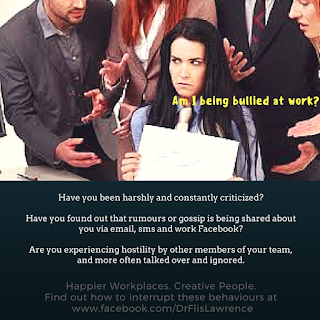Am I being bullied? 25 tactics used by bullies.
This article is the first of a series on how to recognise & interrupt online & offline workplace bullying
Next week I’ll be writing about the strategies currently used to stop workplace bullying, and their efficacy.
Yesterday I received an
email from ‘Dan’ who asked, ‘Am I being bullied, or am I just being neurotic
and dumb?’
The behaviours he
described included being falsely accused of making work-related errors, being
talked over or stared at during meetings, and ‘walking on eggshells’ because
the perpetrator’s 90 degree mood swings, and being laughed at a he walked out
of his boss’s office.
Yes, Dan, if this is persistent behaviour by someone who is perceived as being in a more powerful position (through their rank or some psychological advantage), then it sounds like you’re experiencing
bullying workplace behaviours, plus some extremely childish behaviour.
In his email, Dan asked
why these behaviours were happening at all?
Research
has found that individuals who exceed accepted organisational performance norms
are punished by their peers or colleagues, usually through “subtle or covert
aggression, such as sabotage, ostracism, or “back-stabbing.”
Why is Dan a target?
You are likely to
be a conscientious worker or don’t quite fit the work culture, who perceived by
the bully as a threat in some way. If you want to learn more about why some
people may accidentally attract or trigger bullying
and mobbing
workplace behaviours, read my article ‘6
tactics to stay sane despite working in toxic workplaces’.
Online and offline workplace bullying.
Online and offline workplace bullying
includes indirect aggression, such as face-to-face or cyber-related gossiping,
social isolation and abuse. This sort of workplace aggression extends
across task and person-related bullying, social isolation, verbal threats, and
threats physical intimidation. I’ve written a very handy article entitled, ‘5
steps to take back your personal control during workplace confrontations’ that
talks about these stages as a violence continuum that begins as discourtesy and
disrespect and transmogrifies into serious forms of verbal and physical
intimidation.
Once the behaviour transforms into open verbal confrontations or abuse, the target
often finds themselves isolated and rejected by their team. Generally speaking,
the bullying is resolved when the target (or victim) leaves the workplace or
team, often at their disadvantage. The perpetrator tends to be left with the
team to bully the next target.
Why is workplace bullying allowed to happen, especially when we know it’s so expensive to workplace productivity?
According to
Lutgen-Sandvik (2011), workplace bullying ‘is condoned through societal
discourses, sustained by receptive workplace cultures, and perpetuated through
local interactions.’
Lutgen-Sandvik (2011) found persistent perpetrators are highly practised in the art of gradually and quietly introducing the bullying so gradually onto a
target’s awareness that it may take weeks or even months before the target realises
the degree of applied manipulation.
Australian research found that online (and offline)
workplace bullying in Commonwealth, State, Territory and local government
organisations equally affects men and women irrespective of their hierarchical status
or position, and arises from both internal and external sources.
25 tactics used by bullies
According to the Workplace Bullying Institute,
the top 25 behaviours or tactics used by workplace bullies are:
1. falsely accused someone of “errors” not actually
made (used 71% of the time)
2. stared, glared, was nonverbally intimidating and was clearly showing hostility (68%)
3. discounted the person’s thoughts or feelings (“oh, that’s silly”) in meetings (64%)
4. used the “silent treatment” to “ice out” & separate from others (64%)
5. exhibited presumably uncontrollable mood swings in front of the group (61%)
6. made up own rules on the fly that even she/he did not follow (61%)
7. disregarded satisfactory or exemplary quality of completed work despite evidence (58%)
8. harshly and constantly criticized having a different ‘standard’ for the Target (57%)
9. started, or failed to stop, destructive rumours or gossip about the person (56%)
10. encouraged people to turn against the person being tormented (55%)
11. singled out and isolated one person from co-workers, either socially or physically (54%) 12. publicly displayed “gross,” undignified, but not illegal, behavior (53%)
13. yelled, screamed, threw tantrums in front of others to humiliate a person (53%)
14. stole credit for work done by others (47%)
15. abused the evaluation process by lying about the person’s performance (46%)
16. “insubordinate” for failing to follow arbitrary commands (46%)
17. used confidential information about a person to humiliate privately or publicly (45%)
18. retaliated against the person after a complaint was filed (45%)
19. made verbal put-downs/insults based on gender, race, accent or language, disability (44%)
20. assigned undesirable work as punishment (44%)
21. made undoable demands– workload, deadlines, duties — for person singled out (44%)
22. launched a baseless campaign to oust the person and not stopped by the employer (43%)
23. encouraged the person to quit or transfer rather than to face more mistreatment (43%)
24. sabotaged the person’s contribution to a team goal and reward (41%)
25. ensured failure of person’s project by not performing required tasks: signoffs, taking calls, working with collaborators (40%)
For easy
and effective tactics to successfully deal with, and stop workplace bullying, read my articles ‘5
steps to take back your personal control during workplace confrontations’
and ‘6
risk management strategies to interrupt negative workplace behaviours.’
Next week I’ll be
writing about the strategies currently used to stop workplace bullying, and
their efficacy.
Dr Flis has a BA SSc and a PhD in
organisational social psychology and works with individuals and organisations
as a consultant, speaker and trainer. She uses her social science expertise to
enhance interactions between organisations and the people who lead and work in
them by fostering new insights for diagnosing organisational problems, and
build new capabilities and culture.
Contact Dr Flis at DrFlisLawrence@gmail.com, LinkedIn or follow Flis on her blog Twitter or Facebook.










No comments :
Post a Comment